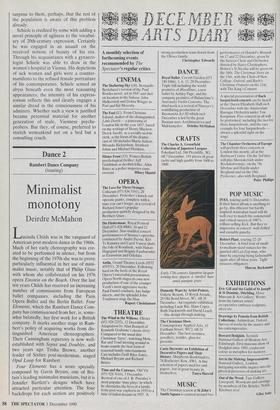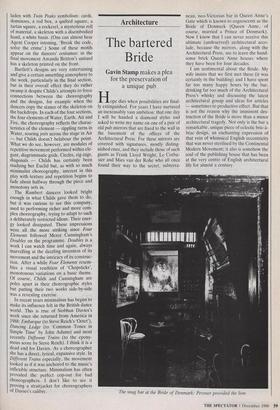Dance 2
Minimalist monotony
Deirdre McMahon
Lucinda Childs was in the vanguard of American post-modern dance in the 1960s. Much of her early choreography was cre- ated to be performed in silence, but from the beginning of the 1970s she was to prove particularly influential in her use of mini- malist music, notably that of Philip Glass with whom she collaborated on his 1976 opera Einstein on the Beach. Over the last ten years Childs has received an increasing number of commissions from European ballet companies, including the Paris Opera Ballet and the Berlin Ballet. Four Elements, which the Rambert Dance Com- pany has commissioned from her, is, some- what belatedly, her first work for a British company. It marks another stage in Ram- bert's policy of acquiring works from dis- tinguished American choreographers. Their Cunningham repertory is now well- established with Septet and Doubles, and two years ago Trisha Brown, another leader of Sixties post-modernism, staged Opal Loop for Rambert.
Four Elements has a score specially composed by Gavin Bryars, one of Bri- tain's leading minimalist musicians, but it is Jennifer Bartlett's designs which have attracted particular attention. The four backdrops for each section are positively
laden with Twin Peaks symbolism: cards, dominoes, a red box, a quilted square, a tartan square, a cockerel, a mysterious roll of material, a skeleton with a disembodied hand, a white basin. (One can almost hear Agent Cooper intoning, 'Break the code, solve the crime'.) Some of these motifs appear on the dancers' costumes: in the final movement Amanda Britton's unitard has a skeleton printed on the front.
Bartlett's designs are very entertaining and give a certain unsettling atmosphere to the work, particularly in the final section, but in their overall effect they do rather swamp it despite Childs's attempts to force connections between the choreography and the designs, for example when the dancers copy the stance of the skeleton on the backdrops. In each of the four sections, the four elements of Water, Earth, Air and Fire, the choreography reflects the charac- teristics of the element — rippling turns in Water, soaring fetes across the stage in Air — but Childs doesn't belabour the point. What we do see, however, are modules of repetitive movement performed within ele- gant, diagrammatic grids. Circles, zig-zags, diagonals — Childs has certainly been studying her Euclid but, as with so much minimalist choreography, interest in this play with texture and repetition begins to fade about halfway through the piece and monotony sets in.
The Rambert dancers looked bright enough in what Childs gave them to do, but it was curious to see this company, used to performing richer and more com- plex choreography, trying to adapt to such a deliberately restricted idiom. Their ener- gy looked dissipated. These impressions were all the more striking since Four Elements followed Merce Cunningham's Doubles on the programme. Doubles is a work I can watch time and again, always marvelling at the dazzling invention of its movement and the intricacy of its construc- tion. After a while Four Elements resem- bles a visual rendition of 'Chopsticks', monotonous variations on a basic theme. Of course, Childs and Cunningham are poles apart in their choreographic styles but putting their two works side-by-side was a revealing exercise.
In recent years minimalism has begun to make its influence felt in the British dance world, This is true of Siobhan Davies's work since she returned from America in 1988: Embarque (to Steve Reich's 'Octet'), Dancing Ledge (to 'Common Tones in Simple Time' by John Adams) and most recently Different Trains (to the epony- mous score by Steve Reich). I think it is a dead end for Davies. As a choreographer she has a direct, lyrical, expansive style. In Different Trains especially, the movement looked as if it was anchored to the music's inflexible structure. Minimalism has often provided the perfect cop-out for bad choreographers. I don't like to see it proving a straitjacket for choreographers of Davies's calibre.











































































 Previous page
Previous page